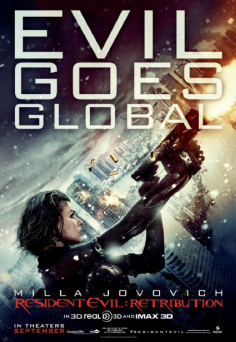By Michael Scoular (The Cascade) – Email
Print Edition: September 19, 2012
 Resident Evil: Retribution springs to life about one minute in screentime following the epilogue of 2010’s Afterlife. In this time constraint, rather than jump headlong into whatever chaos of battle awaits, director Paul W.S. Anderson undulates and inverts events, beginning an exegesis of his own style and the entire series. tomandandy’s electro-symphonic dubs and strains return from Afterlife as probably the best Resident Evil musical fit. Within their surrounding noise, Anderson’s shots, all fluid, violent slow motion, enhanced in reverse, collapse into the black hole of the space between the two movies, then emerge as slammed together cuts. Overwhelming whatever story questions might exist, Anderson’s images do all the explanation, turning the recycled into something new.
Resident Evil: Retribution springs to life about one minute in screentime following the epilogue of 2010’s Afterlife. In this time constraint, rather than jump headlong into whatever chaos of battle awaits, director Paul W.S. Anderson undulates and inverts events, beginning an exegesis of his own style and the entire series. tomandandy’s electro-symphonic dubs and strains return from Afterlife as probably the best Resident Evil musical fit. Within their surrounding noise, Anderson’s shots, all fluid, violent slow motion, enhanced in reverse, collapse into the black hole of the space between the two movies, then emerge as slammed together cuts. Overwhelming whatever story questions might exist, Anderson’s images do all the explanation, turning the recycled into something new.
Calling Retribution a complete reinvention, however, wouldn’t be entirely true. The series’ checkmarks remain: the overarching premise of viral outbreak, the series’ heroine Alice (Milla Jovovich) pitted against the Umbrella Corporation, an entity with its fingers in everything, continuing unchecked following a disaster of its own making, and a time and space constraint, with the series here returning to below surface level. What sets Retribution apart from the other Resident Evils is its engagement with its source. The series has always drawn on story ideas and character descriptions from the Capcom horror-shooter, but in Retribution Anderson extracts the relation between artifice and surveillance in video games and allows it to spiral into all its possibilities in the world of sets, digital doubles, and ruling architecture he has created.
This feeling has existed in the series for its entire life. Witness the everpresent corporate satellite and wireframe mapping out of landscapes stealing images, tracking movement, and frequently overtaking visual space. By invoking the mingling of alternate worlds, “real” and synthetic, and combining them, the Resident Evil series is yanked, turned, and careened into itself. The narrative isn’t the first of its kind, it’s one of the most characteristic, and often the best, of the science-fiction genre, but in Anderson’s hands it acquires its own unique bend. Away from the climaxes there are ideas and archetypes reshaping each other constantly, in grand, but also small ways, as in a subway shelter exchange of glances and instructions. Jovovich, playing multiple roles as in the great A Perfect Getaway, is able to not only execute stunts but also lines and looks that stand out among the constant wreckage. The Resident Evil series, even in the gaps between action, is visibly conflicted between the visceral and calculating headspaces of its soldiers and victims.
Anderson possesses a deftness in visualizing all this, flipping between those ranges and multiple plotlines, crafting a whole with the parts laid bare. His images roar by, so unstoppably kinetic it would be impossible to catalogue the held images and flights of transition that make up Retribution after just one viewing. The cinema of Paul Anderson when tied to the Resident Evil series is one of exhausted compulsion in response to devitalized horror, visuals spanning earth-cycles yet demanding neither of those two actions. Retribution is not simply a compulsive watch, there is a probing, a messiness to so much of Anderson’s work. It rejects, even as it uses, the form of the franchise. The repeated tests in Tokyo, deliberately replaying memorable scenes, wouldn’t have the effect they do without the prior success of the Resident Evil series. But the way the early scenes that stay with Alice throw out ideas of audience coaxing, and in the contextualization of product placement, there is the strong refusal of monolithic processes. As in Paul Verhoeven’s Total Recall the surroundings turn the ludicrous into something properly menacing, setting up their Metropolis end, a transposition with pounding, chaotic emphasis.
For many, the Resident Evil movies represent an easy binary, whether gratuitously violent (yes, you will see zombies shot in the head and bones break), or resembling enough the video games they love to turn viewers off/on. As an entry in the genre, it is a fast and faster excursion into the mad and thrilling. Like all the Resident Evils, it is quick, at around an hour and a half, and to the point, as Anderson rarely uses long streams of dialogue except in cartridges of exposition to catch-up the uninitiated (a previously on segment is a staple of the series now) or set-up an hour’s worth of action (a timer of two minutes keeps even that to a minimum). But Retribution is more than and an embrace of its name, it’s a gloriously offensive ballet of world-saving through sustained uprising and a beautifully, classically composed survival of talent in a world overrun by conditions saying that biology is only good for battle.


